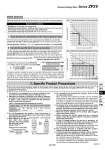
4-p1175-1267-zp2_en 72 / 106
10秒後にBOOKのページに移動します
Connection thread size for pad side Fixed orifice size (mm) Minimum operating flow rate (L/min (ANR)) Q2 M8 0.5 5.0 Chart 1. Flow-rate Characteristics of Vacuum Generator .100 .90 .80 .70 .60 .50 .40 .30 .20 .10 0 0 10 20 30 40 50 60 70 80 90 100 110 Suction flow rate (L/min (ANR)) Vacuum pressure (kPa) Table 1. Relationship between Minimum Operating Flow Rate and Fixed Orifice Size Connection thread symbol for pad side Thread size Recommended pad diameter (mm) A5 B5 B6 A8 A01 B01 AG1BG1 AN1 BN1 M5 25 or less 32 to 50 M6 M8 R1/8 G1/8 NPT1/8 Table 1. Recommended Pad Diameter per Product Vacuum generator side Name plate Fig. 1. Mounting direction Pad side Vacuum generator side Pad side (Vacuum generator side) (Pad side) Enlarged view of name plate No.0.8 ZP2V-A5-03 G MP MADE IN JAPAN N = 6 (unit) Q1 = 31 L/min (ANR) Q2 = 5.0 L/min (ANR) .100 .90 .80 .70 .60 .50 .40 .30 .20 .10 0 5 10 15 20 25 30 35 Suction flow rate (L/min (ANR)) Vacuum pressure (kPa) Chart 2. Selection Example by Min. Operating Flow Rate q w e Example) Vacuum saving valve used: ZP2V-A8-05 From Table 1, Q2 can be calculated as 5.0 L/min (ANR). N = . 6 (unit) 31 {L/min (ANR)} 5 {L/min (ANR)} Select the quantity of vacuum saving valves that can be used with one vacuum generator. Selection Conditions Workpiece: No leakage and several sizes Required vacuum pressure: .50 kPa or more of vacuum pressure per vacuum pad Part number of vacuum saving valve used: ZP2V-A8-05 (Connection thread size for pad side: M8, Fixed orifice size: o0.5) Model Selection Find the minimum operating flow rate (Q2) and the suction flow rate (Q1) of the vacuum generator from the specifications table (page 1236), and calculate the quantity (N) of vacuum saving valves that can be used with one vacuum generator. Check the flow-rate characteristics of the vacuum 1 generator used. 2 Calculate the quantity (N) of vacuum saving valves. From the flow-rate characteristics of the vacuum generator (Chart 1), calculate the suction flow rate (Q1) of the vacuum generator from the required vacuum pressure. Vacuum pressure .50 kPa (q→w→e) = Suction flow rate (Q1) . 31 L/min (ANR). Specific Product Precautions Be sure to read before handling. Refer to front matter 35 for Safety Instructions and pages 899 to 901 for Vacuum Equipment Precautions. 1. The product is not equipped with a vacuum holding function, and cannot be used for the purpose of holding vacuum. 2. Determine the quantity of products to be used by selection, and keep the recommended pad diameter per product shown in Table 1. Also, check the operation with the customer’s machine sufficiently beforehand. 3. Do not disassemble the product. Once the product is disassembled and reassembled, it will not be able to satisfy the original performance. 4. When piping, do not get the pad side and vacuum generator side of the product the wrong way round. (Refer to Fig. 1.) 5. For mounting and removing the product, strictly follow the instructions below. When mounting and removing the product, use the specified places shown in page 1239 to apply tools. Also, when mounting, tighten to the specified torque shown in page 1239. Excessive torque or applying a tool to places other than the specified place can cause damage or loss of original performance. 6. The reduction of the vacuum pressure while the work piece is sucked and released depends on the flow-rate characteristics of the vacuum generator. Check the flow-rate characteristics of the vacuum generator before checking the operation with the customer’s machine. 7. When the built-in element of the product gets clogged, replace the whole product. 8. When verifying the suction using such as a pressure sensor, check the operation with the customer’s machine sufficiently beforehand. 9. If there is leakage between the pad and a workpiece, for example if the workpiece is permeable, the quantity of products that can be used with one vacuum generator is reduced. Take the leakage between the pad and workpiece into account and check the operation with the customer’s machine sufficiently before using. 10. Any mounting direction is available with this product. (Upward or lateral mounting is also available.) 11. For vacuum piping, select equipment and piping so that the “Minimum operating flow rate” in the specifications on page 1236 is secured. Make sure that there are no unnecessary restrictions or leaks, etc., along the course of the piping. If the minimum operating flow rate listed in the specifications is not secured, operation will be unstable, which may lead to suction failure or cause damage to internal parts. Suction flow rate of vacuum generator (Q1) Minimum operating flow rate (Q2) Quantity of vacuum saving valves (N) = Vacuum Saving Valve Series ZP2V The above selection example is based on a general method under the given selection conditions, and may not always be applicable. For vacuum piping, select equipment and piping so that the “Minimum operating flow rate” in the specifications on page 1236 is secured. A final decision on operating conditions should be made based on test results performed at the responsibility of the customer. 1237 ZP3 ZP2 ZP ZPT ZPR XT661 ZP2V A